31.5: Arguments for and Against Protectionist Policy
- Last updated
- Save as PDF
- Page ID
- 4748

- Boundless
- Boundless
National Security Argument
National security protectionist arguments pertain to the risk of dependency upon other nations for economic sustainability.
learning objectives
- Evaluate the arguments in favor of the use of trade protectionism in the security industry
Economic interdependence and globalization has resulted in a system, where each country is largely dependent upon other countries for economic sustainability (though to varying degrees). This results in a substantial national security threat in the form of conflicting or offensive trade strategies between countries. Indeed, economics is often used directly as a weapon of war and conflict via trade sanctions. This highlights a critical protectionist argument pertaining to the very real risk of dependency upon other nations for economic sustainability.
Trade and Conflict
An interesting discussion in economics is the relationship between trade and conflict. It has been noted, somewhat intuitively and empirically, that conflict reduces trade. However, is it also the case that trade reduces conflict? This question is largely unanswered, although the stances are becoming more highly developed. It is hypothesized that trade does not necessarily reduce conflict, but instead changes the nature of the conflict. Economic levers are much more practical than military levers, and are often used for similar reasons. For this reason, it is difficult to separate trade and conflict completely because there is some critical overlap between the two. This is a fundamental foundation for the trade protectionism logic from a national security perspective.
Trade During Conflict
A more specific context for trade and conflict can be the way in which trade is complicated during wartime. Indeed, trade during wartime can be a substantial threat to a nation depending on the scale and scope of the conflict (most notably who is involved). For example, consider World War II. In this scenario Germany was largely isolated in the conflict, and therefore had extremely limited trade partners. Direct conflict will almost always result in a complete cease in trading not only between the country in which the war is occurring, but also any of that country’s allies (who may or may not be directly involved). However, some argue self-sufficiency (via protectionism) in war is not necessary, as friendly nations will still provide trade and economic support.
Sanctions also play a dramatic role as an offensive militaristic maneuver. Iran and North Korea are strong modern examples as well as the recent history of the U.S.-Iraq war. In all of these circumstances, either the U.S. alone or along with a number of allies (representing substantial consumption percentages) actively limited the ability for these countries to trade and generate economic value for their nations (and subsequently their people). While this looks purely economic, it has important social and humanitarian implications as well. The chart makes this case quite clearly, pointing out the death toll in wartime if economic levers are utilized.
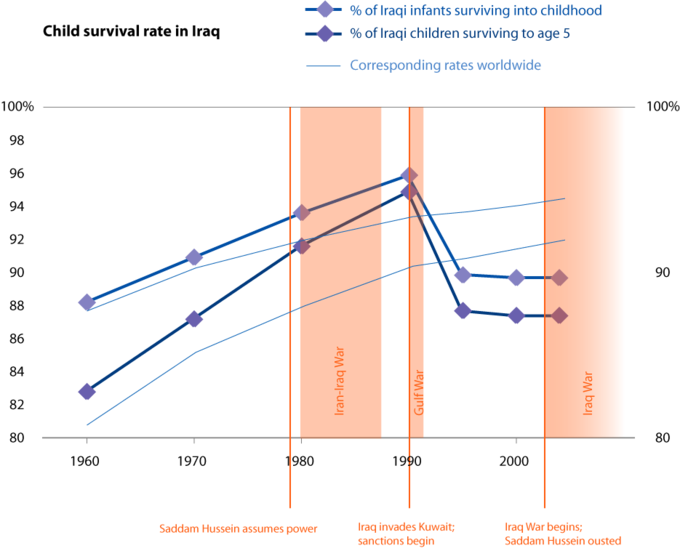
Infant Mortality in Iraq During Sanctions: This graphic underlines the indirect consequences of employing economic levers (i.e. sanctions) in a militaristic fashion during a conflict. While the justification for these figures is complex, including other war-related factors, the correlation is quite clear. Diminishing a country’s economic prospects will in turn result in loss of life, particularly in developing nations.
Protectionism
Combining these ideas, it is clear that there is substantial national security value to trade protectionism. However, the opportunity cost of leveraging the ever-growing global markets make this an unattractive prospect if taken to any extreme, as the benefits of global trade rapidly offset the risk of economic dependency upon hostile nations.
Infant Industry Argument
Economic markets are inherently competitive and newer economies are vulnerable to their more developed counterparts in other countries.
learning objectives
- Discuss the use of trade protectionism to promote new industries
Trade protectionism is defined as national policy restricting international economic trade to alter the balance between imports and goods manufactured domestically, usually executed via policies and governmental regulations such as import quotas, tariffs, taxes, anti-dumping legislation, and other limitations.
Arguments for Protecting Infant Industry
The primary purpose for this system is as the name implies: protection. Economic markets are inherently competitive, and newer economies are highly vulnerable to their more developed counterparts in other countries for a variety of reasons. The infant industry argument is that new industries need protection until they have become efficient enough to compete in the world market.
Despite the standard argument from mainstream economists postulating that free trade and open markets is the ideal system to allow for capitalistic development, there are many economists who believe that some degree of protectionism is the only way to minimize income gaps and substantial inequity from economy to economy (see ). The primary advantage to countries with higher economic power and bigger corporations is simply economies of scale and economies of scope, in addition to being further along the experience curve.
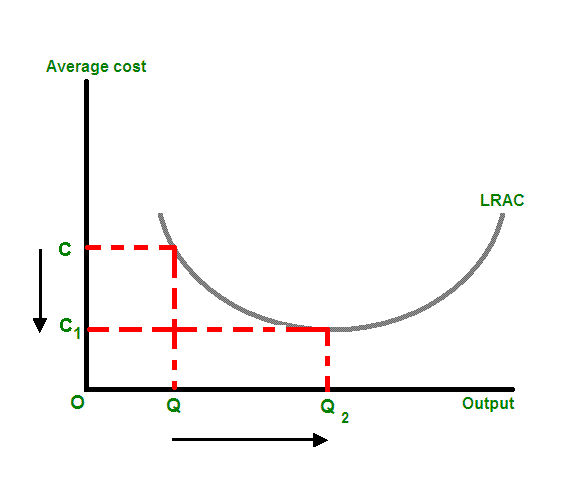
Economies of Scale: The basic premise behind economies of scale is that higher production quantity reduces cost per unit, ultimately allowing for the derivation of economic advantage in the market. Infant industries generally do not have the capacity to do this.
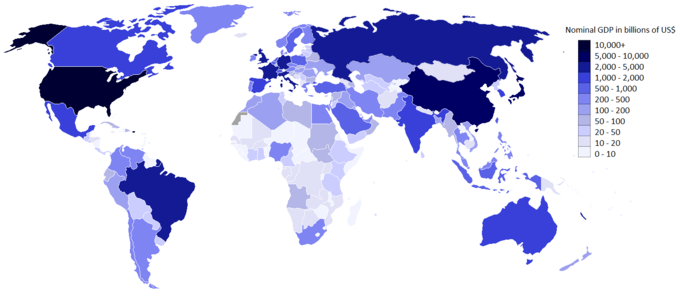
GDP by Country: This map demonstrates the vast difference in overall economic power across the globe, underlining the inequities that need to be addressed in economic policy formulation.
History has proven the value of protection for the countries employing tariff-based international trade policies. Alexander Hamilton first pointed out the inequities of developing economies with young industry in 1790, which was later picked up and developed by Daniel Raymond and Friedrich List in the 19th century. Around this time frame, the United States was employing heavy tariffs to protect their fragile economic system as the economy began to achieve autonomy after British rule. Indeed, Britain employed similarly protectionist policies during this time frame, setting the tone for large economic expansion in the longer term.
Criticism
Of course, protective policy while industry develops domestically is not a cure all. In Brazil in the 1980’s there were heavy protective policies in place to defend Brazil’s nascent computer industry from highly evolved competitors internationally. While this seemed practical, what ended up happening was quite damaging for Brazil. Technology advanced rapidly, and without strategic alliances on a global scale, Brazil largely missed out on these advances. This protectionism seems to have damaged industry prospects on a global level for Brazil in this scenario.
From a broader and more far-reaching perspective, protectionism as a general principle has been heavily criticized (even in infant industry situations). The reason for this is quite simply the significant jump in prosperity as international trade expanded, and the huge capacity for specialization, economies of scale, technology sharing, and a host of other advantages that have been a direct result of free global markets. The problem still remains, however, that this prosperity is often unregulated and of the greatest benefit to the influential players in established economies, sometimes at the expense of exploitation of developing nations (cheaper labor, reduced governmental oversight, etc.). As a result of this, protecting infant industries can benefit the nation employing them, but generally with the opportunity cost of global value.
Unfair Competition Argument
One of the strongest arguments for trade protectionism is unfair competition emerging due to differences in policy and enforcement ability.
learning objectives
- Examine the use of protectionism as a way of addressing unfair competitive practices
Protectionist policies are a highly charged topic in economic debates, as economies work to attain the optimal balance of free trade and trade protectionism to capture the most value. In many ways, the global markets are torn between pursuing what is best on the global level and what is best at the domestic level, and there is sometimes dissonance between the two. One of the strongest arguments for some degree of trade protectionism is the tendency for unfair competition to emerge, particularly in developing markets without the infrastructure to monitor their businesses and enforce penalties. This is called the unfair competition argument.
Dumping
A popular recent topic is anti-dumping policies directed at international players looking to undercut domestic business through selling at dramatically reduced prices. This can be a substantial threat, particularly from economies where labor laws are lax and workers are exploited to create extremely low cost goods. This is also a risk when governments get too involved in business, a criticism often pointed out in China. Governments can provide subsidies to reduce costs for domestic companies. This can also be a threat in infant industries, where larger and more established players can push out smaller players via undercutting prices, absorbing losses until the competition goes bankrupt.
Offsetting this threat has been an ongoing struggle, with the emergence of international trade agreements and organizations like the World Trade Organization (WTO) playing an increasingly large role. One of the struggles with international trade is the difficulty of enforcement between nations, and the WTO plays a critical role in identifying malpractice and addressing it.
Intellectual Property
Another critical risk in the global market is intellectual property (IP) protection. Patents, in a domestic system, protect the innovator to allow them to generate returns on the substantial time investment required to invent or innovate new products or technologies. On a global scale, however, it is quite common for developing nations to copy new technologies via reverse engineering. This results in copycats violating the patents in an environment where the infrastructure domestically will probably not take legal action. This reduces the desire for innovation and places large economic risks on countries dependent upon this for growth.
This is addressed through international patent laws and trade agreements as well, alongside political pressures such as raising tariffs and placing import quotas on countries suspected to be in violation of patents. The downside to this is that utilizing these measures creates political unrest, global factions, and strained business relationships.
Mergers, Acquisitions, and Market Dominance
Another unfair competition threat is the emergence of global monopolies. Some of the larger ones attain enough global power and geographic diversification to be difficult to break up via domestic antitrust laws. demonstrates the substantial threat of deadweight losses being incurred in economies where consolidation results in a lack of competitive forces to drive down price.
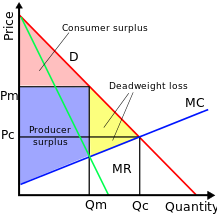
Economic Losses in a Monopoly: This chart highlights the very real risk of lost economic value in a monopolistic situation (deadweight loss in yellow).
On the domestic level monopolies are widely seen as being addressed (though this is hotly debated by many economists in light of the ‘too big to fail’ and ‘too big to jail’ banks). On a global scale it is even more difficult to regulate, as the size and scale of these companies often extends beyond the power of the governments where these companies are located. This is addressed through international standards and trade agreements, standardizing governmental policy on a global level to reduce the risk of monopoly and unfair consolidation towards market dominance.
Jobs Argument
Many policy makers who are proponents of trade protectionism argue that limiting imports will create or save more jobs at home.
learning objectives
- Analyze the use of trade restrictions for strategic purposes
Many policy makers who are proponents of trade protectionism make the argument that limiting imports will create more jobs at home. This argument is predicated on the idea that buying more domestically will drive up national production, and that this increased production will in turn result in a healthier domestic job market. Domestic industries will not have to compete with foreign producers, and are therefore protected from losing marketshare to cheaper imports.
Trade Balance
It is useful to consider the concept of a trade balance, or net exports, in the context of the jobs argument. It is interesting to look at to assess the extremity to which some nations are ‘consumer nations’ and others are ‘producer nations’. The U.S. and China are a great example of opposite sides of the spectrum, where the trade balance is heavy on one side of the spectrum.
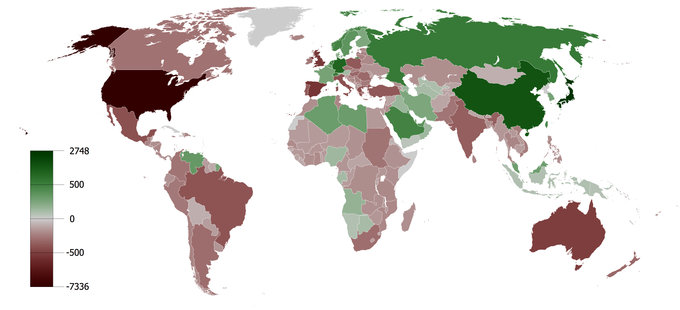
Trade Balances on a Global Scale: It is interesting to look at this graph and assess the extremity to which some nations are ‘consumer nations’ and others are ‘producer nations. ‘ The U.S. and China are a great example of opposite sides of the spectrum, where the trade balance is heavily on one side of the spectrum.
In the U.S. this has created a dramatic push for trade protectionism policies; something the United States has not actively pursued in quite some time. The disastrous 2008 economic collapse via the clear-cut abuses by the banks, and the resulting drop in employment rates, has created an incredibly tangible social and political agenda to bring production back to domestic jobs from overseas. This sentiment towards protectionism is a direct result of the jobs argument in view of an imbalanced trade ratio, where more exports (production and jobs at home) are required to sustain the ongoing consumption of imports.
Outsourcing
Along similar lines, it is common practice for companies to identify strategic alliances abroad and send much of the production work to these locations. This is often a result of cheaper labor and easier systems of governance in those regions. The obvious perspective, from a policy making context, is that these are jobs lost to overseas competitors. While this perspective is often criticized for being short-sighted and against the modern economic view of free markets, it has resulted in policy makers providing incentives to ‘bring jobs back home. ‘
This idea of limiting outsourcing in light of the protectionist jobs argument has resulted in governmental subsidies that work to offset the costs of manufacturing domestically (in the U.S. particularly). These subsidies are essentially grants or tax breaks for companies operating domestically and creating jobs, driving up employment rates via protectionist strategies.
Trade Restriction Strategies
Offsetting the threats of outsourcing and trade imbalances and driving domestic purchasing, and thus domestic production, is done through a variety of political vehicles. Most notable among them are:
- Import Quotas: This is the act of limiting the number of a certain good that can be purchasing from a given country, ensuring that domestic producers maintain a portion of the market share.
- Tariffs: Tariffs are fairly straight-forward, essentially taxes to bring goods into a given country. High tariffs will raise the cost for foreign producers to sell their goods in a domestic system, providing strategic advantages for local producers. One of the pitfalls of tariffs is the likelihood of retaliation, where the foreign government returns with similar tariffs. This will in turn damage global prospects for domestic suppliers.
- Anti-dumping:Anti-dumping legislation actively offsets the ability of low cost or highly subsidized producers in foreign countries to undercut prices in a domestic system. Dumping is the process of selling goods far below market value to drive out competition, often in pursuit of creating a monopoly.
- Subsidies: On the other end of the spectrum, and as noted above, governments can provide subsidies to domestic producers to lower their costs and drive up competitive ability. This can in turn create jobs.
A Summary of International Trade Agreements
International trade agreements are agreements across national borders that reduce or eliminate trade barriers to promote economic exchange.
learning objectives
- Identify at least three main international trade agreements
International trade agreements are trade agreements across national borders intended to reduce or eliminate trade barriers to promote economic exchange. International trade encounters a variety of obstacles, some of which pertain to the protectionism identified in other atoms, which reduce trade incentives. This is usually through tariffs, quotas, taxes, and other trade restrictions. It is also useful to create standards and norms across different countries, particularly for things like intellectual property law recognition, which enables businesses to operate across borders.
There are quite a few international trade agreements, some of which are more formal than others. The trade agreements below provide a fairly comprehensive overview of the current international trade environment:
World Trade Organization (WTO)
The WTO is the largest international trade organization, replacing the General Agreement on Tariffs and Trade (GATT) in 1995, designed to enable international trade while reducing unfair practices. In many ways, the WTO is more complex than other international trade agreements because it incorporates a variety of smaller agreements into a larger framework. The WTO includes upwards of 60 different agreements alongside 159 official members and 25 observers. underlines how effective and universal international trade agreements are becoming. The WTO performs several objective functions as well if trade disputes arise, acting as a framework for assessing appropriate international trade practices.
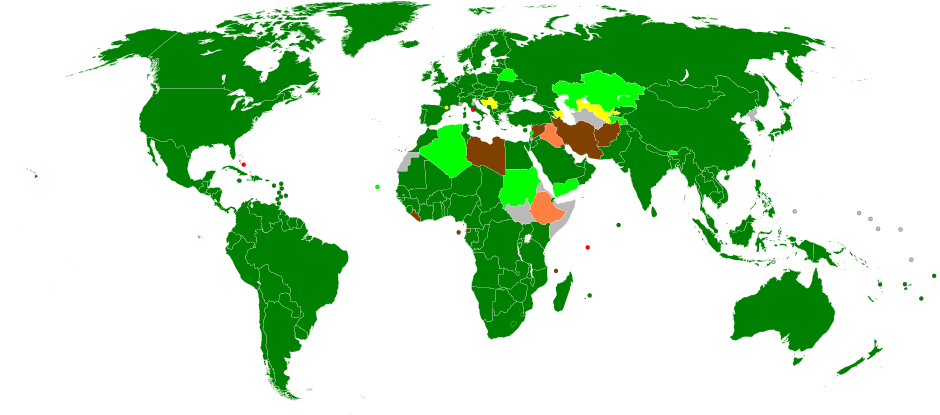
WTO Members: The World Trade Organization (WTO) is an organization designed to oversee and enable international trade. This map shows how successful this has been on a global scale.
The core of the WTO is the most-favored nation (MFN) rule, which states that each WTO member must be charged the lowest tariffs that an importer places on any country. For example, if the US charges Brazil a 5% tariff on imported clothes, and this is the lowest tariff it has placed on any country in the WTO, all other WTO members must also be charged a 5% tariff. Every WTO member gets charged the lowest tariff that an importer charges any other member.
North American Free Trade Agreement (NAFTA)
Unlike the WTO, which is an entirely global approach, most international agreements stem from geographic proximity. NAFTA is a trilateral agreement between the United States, Canada and Mexico designed to minimize any trade or investment barriers between any of these countries (primarily in the form of tariffs). Generally speaking, the United States demonstrates a trade deficit with these countries relative to goods and a surplus relative to services. The United States also demonstrates high and fast-growing foreign direct investment (FDI) in both regions.
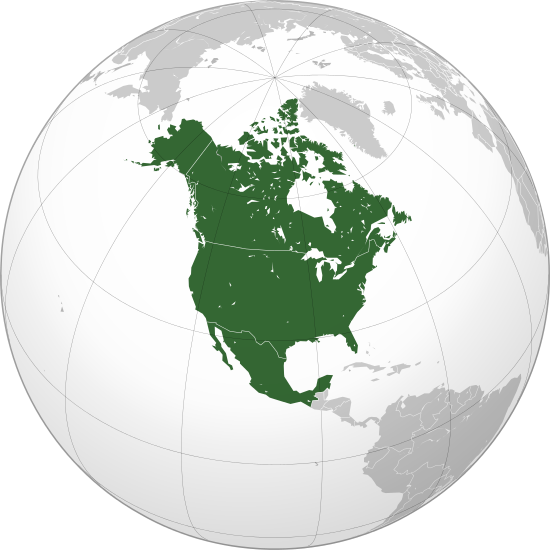
NAFTA Participants: This map outlines each of the countries involved in the North American Free Trade Agreement, an international trade agreement focused on a geographic proximity.
There has been a great deal of controversy surrounding this trade agreement. Agriculture is not included in this agreement, and is often a tough point of discussion for the WTO as well. Mexico is also a point tension due to the fact that it is developing economically (compared to the U.S. and Canada who are considered already developed). Finally, Canadians have often objected to the NAFTA agreements due to the way in which the United States FDI employs hostile takeovers. These agreements demonstrate some of the validity behind trade protectionism and isolationism (as discussed in other atoms in this chapter).
Asia-Pacific Economic Cooperation (APEC)
The APEC forum is particularly interesting in the context of the above agreements, as it is slightly less formal than the above two (it is referred to as a ‘forum’). The APEC forum is a cooperative discussion between 21 countries in the Pacific Rim region promoting free trade, with a focus on newly industrialized economies (NIE). Developing nations gaining access to capital investment and export agreements is the central outcome of APEC, driving economic growth through controlled global expansion. This region represents over half of the world’s GDP and 40% of the overall world population, making this a critical region of the world economy.
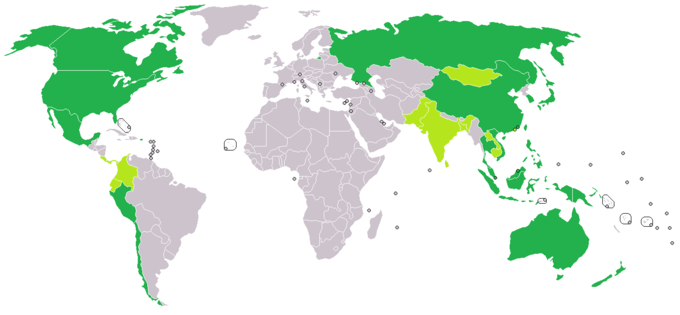
APEC Participants: The Asia-Pacific Economic Cooperation (APEC) is a forum of 21 countries in the Pacific Rim region, focusing on free trade and economic cooperation.
Key Points
- Economic interdependence and globalization has resulted in a unique capitalistic system, where each country is largely dependent upon other countries for economic sustainability.
- It has been noted, somewhat intuitively and empirically, that conflict reduces trade. This highlights the risk of conflict harming an economy.
- A more specific context for trade and conflict can be the way in which trade is complicated during wartime. Indeed, trade during wartime can be a substantial threat to a nation, as economic levers such as sanctions can be utilized.
- Iran and North Korea are strong modern examples as well as the recent history of the U.S.-Iraq war. All of these economies struggle(d) against harsh economic sanctions.
- Combining these ideas, it is clear that there is substantial national security value to trade protectionism.
- Trade protectionism is national policies restricting international economic trade to alter the balance between imports and goods manufactured domestically through import quotas, tariffs, taxes, anti-dumping legislation, and other limitations.
- The primary advantage to countries with higher economic power and bigger corporations is simply economies of scale, which infant industries in developing countries often protect against.
- The United States was employing heavy tariffs to protect their fragile economic system as the economy began to achieve autonomy after British rule, which proved effective.
- From a broader and more far-reaching perspective, protectionism as a general principle has been heavily criticized (even in infant industry situations). The argument is that free markets add value on a global level, while protectionism confines economic value to the nation employing it.
- Protectionist policies are a highly charged topic in economic debates, as economies work to attain the optimal balance of free trade and trade protectionism to capture the most value.
- A recent topic is anti- dumping policies directed at international players looking to undercut domestic business through selling at dramatically reduced prices.
- Another critical risk in the global market is intellectual property (IP) protection as patents are often ignored globally, particularly by countries which lack the infrastructure to enforce IP laws.
- Another unfair competition threat is the emergence of global monopolies. Some of the larger ones attain enough global power and geographic diversification to be difficult to break up via domestic anti-trust laws.
- This argument is predicated on the simply fact that buying more domestically will drive up national production, and that this increased production will in turn result in a healthier domestic job market.
- Local governments leverage subsidies, tariffs, import quotas, and anti- dumping policies to maximize strategic capacity domestically, thus creating jobs.
- A sentiment towards protectionism has developed in the U.S. due to the jobs argument in view of an imbalanced trade ratio, where more exports (production and jobs at home) is required to sustain the ongoing consumption of imports.
- Along similar lines, it is common practice for companies to identify strategic alliances abroad and send much of the production work to these locations (outsourcing), motivating governments to bring these jobs back home.
- Local governments leverage subsidies, tariffs, import quotas, and anti-dumping policies to maximize strategic capacity domestically, thus creating jobs.
- International trade encounters a variety of obstacles which reduce trade incentives. This is usually through tariffs, quotas, taxes, and other trade restrictions.
- The WTO is the largest international trade organization, replacing the General Agreement on Tariffs and Trade (GATT) in 1995, designed to enable international trade while reducing unfair practices.
- NAFTA is a trilateral agreement between the United States, Canada and Mexico designed to minimize any trade or investment barriers between any of these countries (primarily in the form of tariffs).
- The APEC forum is a cooperative discussion between 21 countries in the Pacific Rim region promoting free trade, with a focus on newly industrialized economies (NIE).
Key Terms
- sanction: A penalty, or some coercive measure, intended to ensure compliance; especially one adopted by several nations, or by an international body.
- Self-sufficiency: Able to provide for oneself independently of others.
- Nascent: Emerging; just coming into existence.
- Dumping: Selling goods at less than their normal price, especially in the export market as a means of securing a monopoly.
- Subsidies: Financial support or assistance, such as a grant.
- Reverse engineering: The process of analyzing the construction and operation of a product in order to manufacture a similar one.
- Import Quota: A restriction on the import of something to a specific quantity.
- Trade Balance: The difference between the monetary value of exports and imports in an economy over a certain period of time.
- Foreign direct investment: Investment into production or business in a country by an individual or company of another country.
- tariff: A system of government-imposed duties levied on imported or exported goods; a list of such duties, or the duties themselves.
LICENSES AND ATTRIBUTIONS
CC LICENSED CONTENT, SHARED PREVIOUSLY
- Curation and Revision. Provided by: Boundless.com. License: CC BY-SA: Attribution-ShareAlike
CC LICENSED CONTENT, SPECIFIC ATTRIBUTION
- Isolationism. Provided by: Wikipedia. Located at: en.Wikipedia.org/wiki/Isolationism. License: CC BY-SA: Attribution-ShareAlike
- Free trade debate. Provided by: Wikipedia. Located at: en.Wikipedia.org/wiki/Free_trade_debate. License: CC BY-SA: Attribution-ShareAlike
- Protectionism. Provided by: Wikipedia. Located at: en.Wikipedia.org/wiki/Protectionism. License: CC BY-SA: Attribution-ShareAlike
- Economic sanctions. Provided by: Wikipedia. Located at: en.Wikipedia.org/wiki/Economic_sanctions. License: CC BY-SA: Attribution-ShareAlike
- International trade and state security. Provided by: Wikipedia. Located at: en.Wikipedia.org/wiki/International_trade_and_state_security. License: CC BY-SA: Attribution-ShareAlike
- Self-sufficiency. Provided by: Wiktionary. Located at: en.wiktionary.org/wiki/Self-sufficiency. License: CC BY-SA: Attribution-ShareAlike
- sanction. Provided by: Wiktionary. Located at: en.wiktionary.org/wiki/sanction. License: CC BY-SA: Attribution-ShareAlike
- Provided by: Wikimedia. Located at: upload.wikimedia.org/wikipedi...-mortality.png. License: CC BY-SA: Attribution-ShareAlike
- Isolationism. Provided by: Wikipedia. Located at: en.Wikipedia.org/wiki/Isolationism. License: CC BY-SA: Attribution-ShareAlike
- Free trade debate. Provided by: Wikipedia. Located at: en.Wikipedia.org/wiki/Free_trade_debate. License: CC BY-SA: Attribution-ShareAlike
- Protectionism. Provided by: Wikipedia. Located at: en.Wikipedia.org/wiki/Protectionism. License: CC BY-SA: Attribution-ShareAlike
- Infant industry argument. Provided by: Wikipedia. Located at: en.Wikipedia.org/wiki/Infant_industry_argument. License: CC BY-SA: Attribution-ShareAlike
- Nascent. Provided by: Wiktionary. Located at: en.wiktionary.org/wiki/Nascent. License: CC BY-SA: Attribution-ShareAlike
- Dumping. Provided by: Wiktionary. Located at: en.wiktionary.org/wiki/Dumping. License: CC BY-SA: Attribution-ShareAlike
- Provided by: Wikimedia. Located at: upload.wikimedia.org/wikipedi...-mortality.png. License: CC BY-SA: Attribution-ShareAlike
- Provided by: Wikimedia. Located at: upload.wikimedia.org/wikipedi...al)_in_US$.png. License: CC BY-SA: Attribution-ShareAlike
- Provided by: Wikimedia. Located at: upload.wikimedia.org/wikipedi...s_of_scale.PNG. License: CC BY-SA: Attribution-ShareAlike
- Isolationism. Provided by: Wikipedia. Located at: en.Wikipedia.org/wiki/Isolationism. License: CC BY-SA: Attribution-ShareAlike
- Protectionism. Provided by: Wikipedia. Located at: en.Wikipedia.org/wiki/Protectionism. License: CC BY-SA: Attribution-ShareAlike
- Free trade debate. Provided by: Wikipedia. Located at: en.Wikipedia.org/wiki/Free_trade_debate. License: CC BY-SA: Attribution-ShareAlike
- Commercial law. Provided by: Wikipedia. Located at: en.Wikipedia.org/wiki/Commercial_law. License: CC BY-SA: Attribution-ShareAlike
- Competition law. Provided by: Wikipedia. Located at: en.Wikipedia.org/wiki/Competition_law. License: CC BY-SA: Attribution-ShareAlike
- Unfair competition. Provided by: Wikipedia. Located at: en.Wikipedia.org/wiki/Unfair_competition. License: CC BY-SA: Attribution-ShareAlike
- Subsidies. Provided by: Wiktionary. Located at: en.wiktionary.org/wiki/Subsidies. License: CC BY-SA: Attribution-ShareAlike
- Reverse engineering. Provided by: Wiktionary. Located at: en.wiktionary.org/wiki/Reverse+engineering. License: CC BY-SA: Attribution-ShareAlike
- Dumping. Provided by: Wiktionary. Located at: en.wiktionary.org/wiki/Dumping. License: CC BY-SA: Attribution-ShareAlike
- Provided by: Wikimedia. Located at: upload.wikimedia.org/wikipedi...-mortality.png. License: CC BY-SA: Attribution-ShareAlike
- Provided by: Wikimedia. Located at: upload.wikimedia.org/Wikipedia/commons/0/08/Map_of_countries_by_GDP_(nominal)_in_US$.png. License: CC BY-SA: Attribution-ShareAlike
- Provided by: Wikimedia. Located at: upload.wikimedia.org/Wikipedia/commons/3/38/Economies_of_scale.PNG. License: CC BY-SA: Attribution-ShareAlike
- Provided by: Wikimedia. Located at: upload.wikimedia.org/wikipedi...-surpluses.svg. License: CC BY-SA: Attribution-ShareAlike
- Protectionism. Provided by: Wikipedia. Located at: en.Wikipedia.org/wiki/Protectionism. License: CC BY-SA: Attribution-ShareAlike
- Isolationism. Provided by: Wikipedia. Located at: en.Wikipedia.org/wiki/Isolationism. License: CC BY-SA: Attribution-ShareAlike
- Free trade debate. Provided by: Wikipedia. Located at: en.Wikipedia.org/wiki/Free_trade_debate. License: CC BY-SA: Attribution-ShareAlike
- Import Quota. Provided by: Wiktionary. Located at: en.wiktionary.org/wiki/Import+Quota. License: CC BY-SA: Attribution-ShareAlike
- Trade Balance. Provided by: Wiktionary. Located at: en.wiktionary.org/wiki/Trade+Balance. License: CC BY-SA: Attribution-ShareAlike
- Provided by: Wikimedia. Located at: upload.wikimedia.org/wikipedi...-mortality.png. License: CC BY-SA: Attribution-ShareAlike
- Provided by: Wikimedia. Located at: upload.wikimedia.org/Wikipedia/commons/0/08/Map_of_countries_by_GDP_(nominal)_in_US$.png. License: CC BY-SA: Attribution-ShareAlike
- Provided by: Wikimedia. Located at: upload.wikimedia.org/Wikipedia/commons/3/38/Economies_of_scale.PNG. License: CC BY-SA: Attribution-ShareAlike
- Provided by: Wikimedia. Located at: upload.wikimedia.org/Wikipedia/commons/e/ef/Monopoly-surpluses.svg. License: CC BY-SA: Attribution-ShareAlike
- Provided by: Wikimedia. Located at: upload.wikimedia.org/Wikipedia/commons/3/32/Cumulative_Current_Account_Balance.png. License: CC BY-SA: Attribution-ShareAlike
- Protectionism. Provided by: Wikipedia. Located at: en.Wikipedia.org/wiki/Protectionism. License: CC BY-SA: Attribution-ShareAlike
- Isolationism. Provided by: Wikipedia. Located at: en.Wikipedia.org/wiki/Isolationism. License: CC BY-SA: Attribution-ShareAlike
- World Trade Organization. Provided by: Wikipedia. Located at: en.Wikipedia.org/wiki/World_Trade_Organization. License: CC BY-SA: Attribution-ShareAlike
- North American Free Trade Agreement. Provided by: Wikipedia. Located at: en.Wikipedia.org/wiki/North_American_Free_Trade_Agreement. License: CC BY-SA: Attribution-ShareAlike
- List of free trade agreements. Provided by: Wikipedia. Located at: en.Wikipedia.org/wiki/List_of_free_trade_agreements. License: CC BY-SA: Attribution-ShareAlike
- Asia-Pacific Economic Cooperation. Provided by: Wikipedia. Located at: en.Wikipedia.org/wiki/Asia-Pacific_Economic_Cooperation. License: CC BY-SA: Attribution-ShareAlike
- Foreign direct investment. Provided by: Wikipedia. Located at: en.Wikipedia.org/wiki/Foreign%20direct%20investment. License: CC BY-SA: Attribution-ShareAlike
- tariff. Provided by: Wiktionary. Located at: en.wiktionary.org/wiki/tariff. License: CC BY-SA: Attribution-ShareAlike
- Provided by: Wikimedia. Located at: upload.wikimedia.org/wikipedi...-mortality.png. License: CC BY-SA: Attribution-ShareAlike
- Provided by: Wikimedia. Located at: upload.wikimedia.org/Wikipedia/commons/0/08/Map_of_countries_by_GDP_(nominal)_in_US$.png. License: CC BY-SA: Attribution-ShareAlike
- Provided by: Wikimedia. Located at: upload.wikimedia.org/Wikipedia/commons/3/38/Economies_of_scale.PNG. License: CC BY-SA: Attribution-ShareAlike
- Provided by: Wikimedia. Located at: upload.wikimedia.org/Wikipedia/commons/e/ef/Monopoly-surpluses.svg. License: CC BY-SA: Attribution-ShareAlike
- Provided by: Wikimedia. Located at: upload.wikimedia.org/Wikipedia/commons/3/32/Cumulative_Current_Account_Balance.png. License: CC BY-SA: Attribution-ShareAlike
- Provided by: Wikimedia. Located at: upload.wikimedia.org/Wikipedia/commons/a/a6/North_American_Agreement_(orthographic_projection).svg. License: CC BY-SA: Attribution-ShareAlike
- Provided by: Wikimedia. Located at: upload.wikimedia.org/wikipedi...nlargement.png. License: CC BY-SA: Attribution-ShareAlike
- Provided by: Wikimedia. Located at: upload.wikimedia.org/Wikipedia/commons/9/93/World_Trade_Organization_negotiations.svg. License: CC BY-SA: Attribution-ShareAlike

